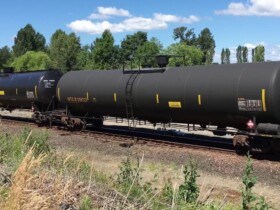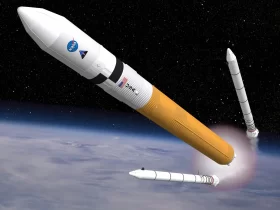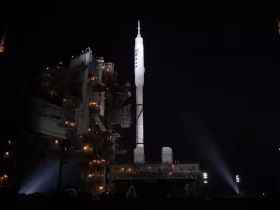Operational Ares I Shown on New Mobile Launcher (NASA)

Ares I was expected to become the third human space launcher developed entirely by the U.S. National Aeronautics and Space Administration (NASA).[1] Ares I was developed to do just one job – launch the Orion Crew Exploration Vehicle. Orion was planned to carry on NASA’s human spaceflight efforts after Space Shuttle was retired in 2010. The launch vehicle and its Orion payload were canceled along with the Constellation Program on February 1, 2010.
The Ares I Crew Launch Vehicle would have consisted of a five-segment solid propellant first stage derived from Space Shuttle’s four-segment reusable solid rocket booster (RSRB) topped by an all-new liquid hydrogen/oxygen upper stage. The upper stage would have been powered by a new J-2X upper stage engine derived, in part, from the J-2 engine used on Apollo/Saturn upper stages and the simplified J-2S engine developed but never flown.
Mission requirements called for the two-stage launch vehicle to insert a 23.27 tonne Orion spacecraft into a -20×185 km x 28.5 deg suborbital trajectory. This would have aimed the spent Ares I second stage toward an Indian Ocean impact while Orion fired its service module engine to complete the ascent to orbit. A service module burn at first apogee would have provided 62 meters per second of additional velocity to circularize the orbit at 185 km, which would have been roughly the same as the “OMS-2” burn used to complete the space shuttle ascent to orbit.
Ares I Description
The Ares I/Orion stack would have weighed about 912 tonnes at liftoff and stood nearly 100 meters to the tip of the launch abort system mast. The launch vehicle itself would have measured about 78.5 meters from its base to the top of its Instrument Unit. The first stage would have been 3.71 meters in diameter, the upper stage 5.5 meters in diameter, and the Orion spacecraft 5 meters in diameter.
The first stage would have produced roughly 1,588 tonnes of thrust at liftoff and averaged 1,245 tonnes of thrust during its roughly 126 second burn. Approximately 627 tonnes of polybutadiene acrylonitride (PBAN) solid propellant would have been consumed during the burn. The movable RSRB nozzle would have provided pitch and yaw control while a new monopropellant roll control system located in the interstage would have controlled vehicle roll during the first stage burn.
First stage separation would have occurred at roughly 59 km at a velocity of about 2,024 meters per second. Booster separation motors would have backed the stage away from the upper stage and interstage, tumble motors would have caused it to enter a slow spin, and the tapered frustum section at the top of the stage would have separated. The stage would have reached a 99 km apogee before beginning its descent. A drogue chute would have begun to deploy when the RSRB passed 4.6 km, having already been slowed by the atmosphere to a speed of about 195 meters per second. The stage would have impacted the Atlantic Ocean under a triple ringsail main chute canopy about 7 minutes 45 seconds after liftoff.
A cylindrical interstage would have connected the RSRB and upper stages. It would have been composed of composite materials, marking the first large-scale use of a composite structural element in a U.S. human-rated launch vehicle. The interstage would have contained important propulsion elements, including the first stage roll control system, the booster separation motors (the 8.39 tonne thrust motors previously located in the RSRB nose), and two interstage separation systems. Plans called for the roll control system to use monopropellant hydrazine thrusters. Thrust would have been produced by the decomposition of hydrazine as it passed through a catalyst bed.
The upper stage J-2X engine would have burned liquid hydrogen and liquid oxygen for about 465 seconds, producing 133 tonnes of thrust at a 448 second vacuum specific impulse. Velocity at shutdown would have been somewhere in the range of 7,800 meters per second.
The J-2X engine would have swiveled to provide pitch and yaw control. Roll control would have been provided by a blow-down system feeding monopropellant hydrazine to a series of attitude control thrusters. Small solid motors would have fired to separate the upper stage from the interstage and to settle propellants.
An aft liquid oxygen tank would have been topped by a forward liquid hydrogen tank, with a common bulkhead between, to compose the upper stage structure. The tanks would have held more than 139 tonnes of propellant. Tanks would have been fabricated from the same 2195 aluminum-lithium alloy used to build shuttle External Tanks. The stage itself would have been assembled at the Michoud External Tank factory in New Orleans.
A cylindrical Instrument Unit would have topped the upper stage. It would have contained guidance and control systems for the entire launch vehicle.
Ares I Development

Ares I Design as of Late 2006 (NASA)

During 2006, NASA awarded the RSRB contract to Alliant Tech Systems (ATK), the Space Shuttle RSRB manufacturer. NASA also awarded J-2X development work to Pratt & Whitney Rocketdyne, ancestor of the company that developed both the Space Shuttle Main Engine and the Saturn J-2 engine. In late 2006, NASA awarded the Orion contract to Lockheed Martin. The Ares I upper stage contract was awarded to Boeing in August 2007. Boeing also won the Instrument Unit contract in December 2007.
First Stage Development
Five Segment Booster DM-2 Test, August 31, 2010

The Ares I RSRB first stage design differed in several ways from the Space Shuttle RSRB. It had five segments instead of four. The nozzle throat diameter was increased. The propellant grain was a different shape and the propellant burn rate was modified. Insulation between the propellant and the casing was also modified.
ATK performed first stage recovery pilot parachute testing in 2006. It cast its first inert segments by mid 2008, which were slated for shipment to MSFC for full scale vehicle vibration testing. The Ares I-X flight test article, a four-segment RSRB from the shuttle probram with a fifth dummy segment added, was shipped to KSC for a mid 2009 launch date. In November 2008, ATK began casting the first segments for the five segment static test article (DM-1) in preparation for the first static test burn in Utah. The DM-1 static test firing was successfully performed on September 10, 2009.
Although NASA planned throughout 2010 to end the Ares 1 and 5 development programs, funding continued to flow for the five segment booster effort. ATK assembled a second test motor for a DM-2 firing, which was successfully performed on August 31, 2010.
Upper Stage Development
The Ares I upper stage and upper stage engine paced paced the launch vehicle schedule. Upper stage development included the construction of a Pathfinder mass simulator for use in testing ground equipment, a “Battleship” stage that would serve as the Main Propulsion Test Article for ground-based test stand burns beginning in late 2010, and a Vibration test article that would be mated to an inert RSRB first stage for vibration testing at Marshall Space Flight Center a year later.
J-2X Engine Development
J-2X injector testing began in 2006. Component, or “powerpack” testing began in 2008 using a “workhorse” gas generator. Initial full-up J-2X testing was not expected to occur until late 2010 at the earliest. Initial testing would have been performed on the Stennis Space Center A-1 Test Stand using the first of five development engines. Test Stand A-2 would have begun supporting J-2X in 2011. Critical thermal/vacuum testing would have been performed at NASA’s Glenn Center Plum Brook Station B–2 site beginning in 2011. Plum Brook’would have hot fire tested a J-2X engine at simulated altitude temperatures and near vacuum pressures.
J-2X would have used the original J-2 gas generator cycle, rather than the tap-off cycle used by the J-2S engine. Upgrades could have included use of a channel-wall main combustion chamber (potentially Vulcain-2 technology provided by Sweden’s Volvo Aero), and a film-cooled nozzle extension.
Turbopumps would have been adapted from the J-2 derived turbopumps used for NASA’s X-33 aerospike engine during the X-33 program. Rocketdyne and NASA hot-fire tested the XRS-2200 aerospike engine in 2000.
Flight Test
Ares I-X Test Vehicle Shown on Shuttle Pad 39B (NASA)

A “Proto-Flight” upper stage (US-1) was initially planned. It would not have a live J-2X engine or thrust vector control system, but would simulate all other aspects of the mission, including staging during a suborbital “Ares I-Y” mission atop a five segment RSRB in mid 2013. A second “Test Flight” article would have flown in mid 2014, this time with a live J-2X engine and an unmanned Orion spacecraft on the “Orion 1” orbital mission. The first crewed Ares I/Orion launch, on the Orion 2 mission, would have occurred no earlier than late 2014. Crewed missions would have flown about twice per year after that in support of the International Space Station. Two or more Orion cargo-only missions might also have occurrd each year using an Orion not topped by a launch abort system.

The precursor “Ares I-X” suborbital test flight, successfully performed on October 28, 2009 from KSC LC 39B, used an existing four-segment RSRB fitted with a dummy fifth segment. This first stage was topped by dummy interstage, second stage, and Orion boilerplate hardware. A live roll control system in the interstage was active during the flight. The $450 million test included stage separation and parachute recovery of the booster stage.
HISTORY OF “THE STICK”
The “Swirling Vortex”
The idea that a Space Shuttle solid rocket booster could serve as the first stage of an in-line multi-stage launch vehicle was apparent from the outset of the shuttle program. Serious study of the concept did not occur until 1993 as an almost accidental offshoot of NASA’s Advanced Transportation Systems Studies (ATSS) program.
1993 ATSS Solid Booster In-Line Concepts (NASA)

The Advanced Transportation Systems Studies effort was a paper study of heavy lift launch system requirements for returning humans to the Moon. It was triggered by a concept named “First Lunar Outpost” that had been headed, interestingly enough, by NASA’s Office of Exploration head Dr. Michael D. Griffin, who is today’s NASA Administrator.
In the midst of the study, Marshall Space Flight Center managers asked one of the contractors (Lockheed Martin) to “define and assess” smaller in-line, two stage launch vehicles that would use strap-on boosters from the lunar heavy lifters as first stages. The managers were looking for an alternative support launcher for NASA’s planned “Freedom” space station. The launch vehicle would launch cargo and, possibly, crew transfer vehicles, to the station.
Among the alternatives defined by Lockheed Martin were a family of vehicle concepts that used partial segment versions of the then-planned Space Shuttle Advanced Solid Rocket Motor (ASRM) as first stage units. The designs were found to “minimize stage development costs while providing high density-impulse during atmospheric flight”. Each concept featured a solid motor first stage topped by liquid hydrogen second stage that was powered by a single Space Shuttle Main Engine (SSME) or by a J-2S, an engine that had been developed during the Saturn Apollo program. Payloads to low earth orbit ranged from 20 to 37 tonnes, with several designs able to lift more than the Space Shuttle. Cost analysis showed that such “single-stick” designs would be cost-efficient both to develop and to operate.
Like many similar studies during the Space Shuttle era, ATSS produced nothing but paper. Frustration was evident in the conclusion section of the Lockheed Martin report, signed by Study Manager James B. McCurry, which included the following refreshingly frank assessment.
“Unfortunately, NASA’s space exploration program was entrained into a swirling vortex of wavering congressional and Executive Branch support and a projection of flat NASA budgets with no room for the growth of major new programs. The net result was to place … the [study] team on a roller-coaster ride of assessing a wide variety of launch vehicle concepts as NASA Headquarters searched for the definition of the Nation’s future space transportation system requirements. … It is hoped that the … analysis efforts documented in this final report will not have been a wasted effort, but will become a legacy for eventual application to NASA’s future space transportation requirements.”
Although it would take more than a decade, McCurry’s team’s efforts would eventually bear fruit. Sadly, it would take the loss of a second shuttle crew and orbiter to trigger the process.
Columbia Triggers Reassessment
Columbia disintegrated during reentry on February 1, 2003. The disaster initiated a gut-wrenching review of NASA’s future human spaceflight plans. During the summer of 2003, NASA contractors were busy conducting a study effort for potential space shuttle replacements. The overall program was called “Space Launch Initiative” (SLI). One part of the program was dubbed “Orbital Space Plane”, or OSP. Another was “Next Generation Launch Technology” (NGLT).
SLI generated the expected Powerpoint presentations, but since it actually began before the Columbia accident it lacked the now-desired focus on nearer-term shuttle replacement. The overall effort did not lead directly to hardware development, but some of the OSP work evolved into the new “Crew Exploration Vehicle” (CEV) program.
While SLI/OSP was underway, some at NASA were revisiting the ATSS SRB in-line concepts, along with the use of crew carrying capsules. NASA’s Astronaut Office became especially supportive of the concept when it became clear that it would be more reliable than any proposed alternative launch method. After Columbia, crew safety had become an overriding requirement for any new launch system. One of the first outside-of-NASA people briefed on the SRB in-line design was then-head of APL, Michael Griffin, who reportedly was impressed by the concept.
ATK’s In-Line SRB “Stick” (ATK)

New “Exploration Transportation System” studies were initiated after OSP ended, and the in-line SRB concept was part of the mix. SRB manufacturer ATK quickly became a champion of he concept. In January 2004, President Bush announced the Vision for Space Exploration, which directed NASA to plan for expeditions to the Moon and Mars.
The SRB in-line launcher, by now dubbed “Stick” by a growing number of observers, was first mentioned to a larger public audience in February 2004, at the Space Shuttle Life Extension Program Summit (SLEP) in Galveston, Texas. In April 2004 Mike Kahn of ATK presented a Space Congress paper that showed a four-segment SRB topped by a new upper stage. The launcher was projected to be able to lift 16-18 tonnes to LEO with a liquid hydrogen upper stage, enough to lift either cargo or a crewed vehicle.
In July 2004, the SRB in-line crew launch vehicle approach was recommended by an independent study for The Planetary Society titled “Extending Human Presence into the Solar System”. The study team included Michael Griffin, William Claybaugh, who currently heads NASA’s Advanced Studies and Analysis Division, and former astronauts Owen Garriott and Bruce McCandless, among others.
Former NASA astronaut Scott Horowitz hired on with ATK and began making presentations about the in-line SRB rocket across the nation, including before Congressional committies. His presentations focused on the proven flight history of the SRBs and on the potential cost-savings provided by using an already-developed 1,500 tonne thrust rocket motor. Horowitz talked about reviving NASA’s J-2S engine for the upper stage. He also described an alternative kerosene-fueled upper stage version loaded with 113 tonnes of propellant that would be able to put 13 tonnes into LEO.
Michael Griffin became the new NASA Administrator, replacing Sean O’Keefe, on April 13, 2005. He immediately established an “Exploration Systems Architecture Study” (ESAS) committee that was asked to define a Moon/Mars mission architecture. Among its tasks was the performance of a full-blown launch vehicle trade study that included clean-sheet designs, EELV-derived designs, and Shuttle-derived designs. The in-line SRB “Stick” was, of course, in the mix. A version that used a four-segment SRB first stage topped by an SSME powered upper stage won the trades for Crew Launch Vehicle, which by this time had surpassed 23 tonnes in mass in order to handle lunar missions.
The ESAS results were announced in October 2005, but when NASA teams began looking at details they decided to replace the SSME with a less-costly “J-2X” engine. At the same time, a decision was made to use a five-segment SRB first stage. This choice would actually save money over the life of the lunar program since the five-segment booster would need to be developed for the heavy-lift “Cargo” launcher. In early 2006, NASA announced the changes. It also named its new rockets “Ares I” and “Ares V”.
Ares I Details (Subject to Change)
| December 2006 | May 2008 | |
| First Stage | 5 Segment RSRB | 5 Segment RSRB |
| GLOW (tonnes) | 734 t | 732.55 t |
| Propellant Mass (tonnes) | 630 t | 627.22 t |
| Dry Mass (tonnes) | 104 t | 104.85 t |
| Diameter (meters) | 3.71 m | 3.71 m |
| Height (meters) (to top of frustum) | 53 m | 53 m |
| Liftoff Thrust (vac. tonnes) | 1,587-1,632 t (sources vary) | 1,588 t |
| Average Thrust (vac. tonnes) | 1,245 t | 1,245 t |
| Specific Impulse (sea level/vacuum, seconds) | 237s/268.8 sec | 237s/265.5 sec |
| Second (Upper) Stage | ||
| GLOW (tonnes) | 143.41 t | 152.70 t |
| Usable Propellant Mass (tonnes) | 128.05 t | 138.32 t |
| Burnout Mass (tonnes) | 15.41 t | 14.38 t |
| Diameter (meters) | 5.5 m | 5.5 m |
| Height (meters) (including interstage) | 26.4 m | 26.4 m |
| Thrust (vac., tonnes) | 133 t | 133 t |
| Specific Impulse (vac., seconds) | 448 sec | 448 sec |
| Interstage | ||
| Total Mass | 4.88 t | 4.16 t |
| Total | ||
| GLOW (tonnes)(including payload) | 908 t | 912.66 t |
| GLOW (tonnes)(not including payload) | 882.29 t | 889.41 t |
| Height (meters)(including payload) | ~95 m | 99.7 m |
| Height (meters) (not including payload) | 79.4 m | 78.45 m |
| Orion (tonnes) to -20×185 km x 28.5 deg/51.6 deg | 23.6 t/21.6 t | 23.26 t/20.31 t |
| Gross Payload Capability (tonnes) to -20×185 km x 28.5 deg/51.6 deg | 26.3 t/23.58 t | 25.41 t/22.69 t |
Footnotes:
[1] Saturn V and Space Shuttle were the other NASA-developed manned launch systems. The Mercury and Gemini launch vehicles were adapted from existing U.S. Army or U.S. Air Force ballistic missiles. ARPA (the Pentagon’s Advanced Research Projects Agency) initiated development of the Saturn cluster booster that evolved into the Apollo/Saturn IB first stage.
References:
Advanced Transportation Systems Studies, Technical Area 2, Heavy Lift Launch Vehicle Development Contract, NAS8-39208, Final Report, Lockheed Martin Missiles and Space for the Launch Systems Concepts Office of the George C. Marshall Space Flight Center, July 1995.
Extending Human Presence into the Solar System, An Independent Study for the Planetary Society on Strategy for the Proposed U.S. Space Exploration Policy, July 2004.
Service Life Extension Program Summit 2, Strategy Panel, Presentation by Doug Cooke, Chair, February 17, 2004.
Exploration Transportation System, Presentation by Mike Kahn of ATK at the 2004 Space Congress, April 2004.
Shuttle Derived Launch Vehicles – A Solution for Space Access, James A. Furfaro and Dennis G. Johnson, ATK Thiokol Inc., 2005.
Fragola, J.R., Putney, B., Minarick, J., Baum, J.D., Franzini, B., Orlando, S., Lohner, R., Mestreau, E.,and Ferricane, R., “Reliability and Crew Safety Assessment for Solid Rocket Booster / J-2S Based Launch Vehicle,” Science Applications International Corp., SAICNY05-04-1, 2005.
NASA’s Exploration Systems Architecture Study (ESAS), Final Report, NASA-TM-2005-214062, November 2005.
Upper Stage Request for Information, NASA’s Exploration Launch Office, March 20, 2006.
Ares Project Status, Presentation by Steve Cook, Director Exploration Launch, NASA, Second AIAA Space Exploration Conference, December 2006.
Author
by: Ed Kyle
Updated: 9/1/2010
















Got a Questions?
Find us on Socials or Contact us and we’ll get back to you as soon as possible.